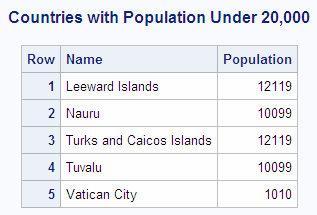Using PROC SQL Options to Create and Debug Queries
Overview of Using PROC SQL Options to Create and Debug Queries
Restricting Row Processing with the INOBS= and OUTOBS= Options
When you are developing queries against large tables,
you can reduce the time that it takes for the queries to run by reducing
the number of rows that PROC SQL processes. Subsetting the tables
with WHERE statements is one way to do this. Using the INOBS= and
the OUTOBS= options are other ways.
The INOBS= option restricts
the number of rows that PROC SQL takes as input from any single source.
For example, if you specify INOBS=10, then PROC SQL uses only 10 rows
from any table or view that is specified in a FROM clause. If you
specify INOBS=10 and join two tables without using a WHERE clause,
then the resulting table (Cartesian product) contains a maximum of
100 rows. The INOBS= option is similar to the SAS system option OBS=.
The OUTOBS= option restricts
the number of rows that PROC SQL displays or writes to a table. For
example, if you specify OUTOBS=10 and insert values into a table by
using a query, then PROC SQL inserts a maximum of 10 rows into the
resulting table. OUTOBS= is similar to the SAS data set option OBS=.
Limiting Iterations with the LOOPS= Option
The LOOPS= option restricts PROC SQL to the number of iterations
that are specified in this option through its inner loop. By setting
a limit, you can prevent queries from consuming excessive computer
resources. For example, joining three large tables without meeting
the join-matching conditions could create a huge internal table that
would be inefficient to process. Use the LOOPS= option to prevent
this from happening.
You
can use the number of iterations that are reported in the SQLOOPS
macro variable (after each PROC SQL statement is executed) to gauge
an appropriate value for the LOOPS= option. For more information,
see
Using the PROC SQL Automatic Macro Variables.
Checking Syntax with the NOEXEC Option and the VALIDATE Statement
To check the syntax of a PROC SQL step without actually
executing it, use the NOEXEC option or the VALIDATE statement. The
NOEXEC option can be used once in the PROC SQL statement, and the
syntax of all queries in that PROC SQL step will be checked for accuracy
without executing them. The VALIDATE statement must be specified before
each SELECT statement in order for that statement to be checked for
accuracy without executing. If the syntax is valid, then a message
is written to the SAS log to that effect. If the syntax is invalid,
then an error message is displayed. The automatic macro variable SQLRC
contains an error code that indicates the validity of the syntax.
For an example of the VALIDATE statement used in PROC SQL, see
Validating a Query. For an example of using the VALIDATE statement in a SAS/AF
application, see
Using the PROC SQL Automatic Macro Variables.
Note: There is an interaction between
the PROC SQL EXEC and ERRORSTOP options when SAS is running in a batch
or noninteractive session. For more information, see SQL Procedure.
Expanding SELECT * with the FEEDBACK Option
The FEEDBACK option expands a SELECT * (ALL) statement
into the list of columns that the statement represents. Any PROC SQL
view is expanded into the underlying query, all expressions are enclosed
in parentheses to indicate their order of evaluation, and the PUT
function optimizations that are performed on the query are displayed.
The FEEDBACK option also displays the resolved values of macros and
macro variables.
Timing PROC SQL with the STIMER Option
Certain operations can be accomplished in more than one way. For
example, there is often a join equivalent to a subquery. Consider
factors such as readability and maintenance, but generally you will
choose the query that runs fastest. The SAS system option STIMER shows
you the cumulative time for an entire procedure. The PROC SQL STIMER
option shows you how fast the individual statements in a PROC SQL
step are running. This enables you to optimize your query.
This example
compares the execution times of two queries. Both queries list the
names and populations of states in the UNITEDSTATES table that have
a larger population than Belgium. The first query does this with a
join; the second with a subquery.
Comparing Run Times of Two Queries shows the STIMER results from the SAS log.
libname sql 'SAS-library';
proc sql stimer ;
select us.name, us.population
from sql.unitedstates as us, sql.countries as w
where us.population gt w.population and
w.name = 'Belgium';
select Name, population
from sql.unitedstates
where population gt
(select population from sql.countries
where name = 'Belgium');Comparing Run Times of Two Queries
4 proc sql stimer ;
NOTE: SQL Statement used:
real time 0.00 seconds
cpu time 0.01 seconds
5 select us.name, us.population
6 from sql.unitedstates as us, sql.countries as w
7 where us.population gt w.population and
8 w.name = 'Belgium';
NOTE: The execution of this query involves performing one or more Cartesian
product joins that can not be optimized.
NOTE: SQL Statement used:
real time 0.10 seconds
cpu time 0.05 seconds
9
10 select Name, population
11 from sql.unitedstates
12 where population gt
13 (select population from sql.countries
14 where name = 'Belgium');
NOTE: SQL Statement used:
real time 0.09 seconds
cpu time 0.09 seconds
Resetting PROC SQL Options with the RESET Statement
Use the RESET statement to add, drop,
or change the options in the PROC SQL statement. You can list the
options in any order in the PROC SQL and RESET statements. Options
stay in effect until they are reset.
This example first uses
the NOPRINT option to prevent the SELECT statement from displaying
its result table in SAS output. The RESET statement then changes the
NOPRINT option to PRINT (the default) and adds the NUMBER option,
which displays the row number in the result table.
Copyright © SAS Institute Inc. All rights reserved.
